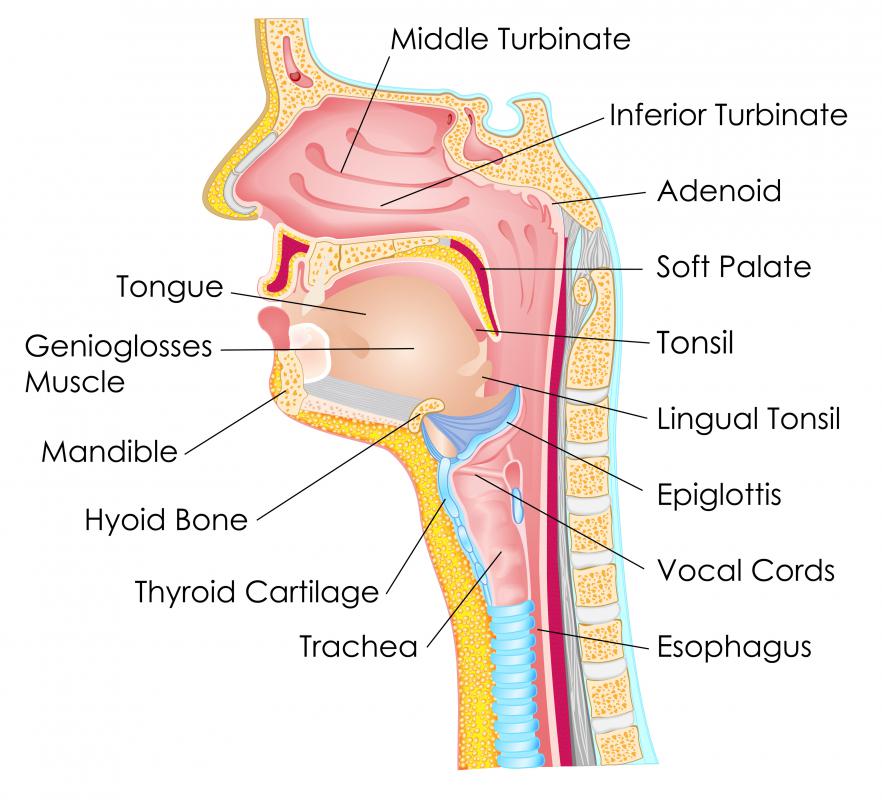At WiseGEEK, we're committed to delivering accurate, trustworthy information. Our expert-authored content is rigorously fact-checked and sourced from credible authorities. Discover how we uphold the highest standards in providing you with reliable knowledge.
What is the Mandible?
In human anatomy, the mandible is the lower jawbone, providing structure to the chin and support for the lower teeth. Another name for the mandible bone is the inferior maxillary bone. It is a U-shaped bone which extends from one ear down to the chin and back up to the ear on the other side of the head. Vertical extensions of the mandible form left and right joints with the main portion of the skull, the cranium, to form the jawbone joints. The name for these joints is the tempero mandibular joints.
In mandible anatomy, names are given to various parts of the jawbone. The main names for the different parts of the mandible are the body, the condoyle, the coronoid process, and the ascending ramus. The body is the middle part of the bone that forms a U-shape and holds the lower teeth.

The condoyles are the rounded projections at both sides of the upper back part of the bone. These round pieces of bone fit into the joint with the cranium on each side of the head, slightly lower than the ear. Together with the cranium sockets and the associated muscle tissue, the condoyles form the jawbone joints.
The coronoid process is a piece of bone that protrudes upwards from the mandible at the back of the teeth. There are two coronoid processes, one at each side of the jaw. The muscles that are used for chewing are attached to the coronoid processes and they then attach to the cranium.
The ascending ramus is the name for the portion of bone that joins the U-shaped body of the jawbone to the condoyles and the coronoid processes. The ascending ramus is typically a flat portion of bone. It gives shape to the facial jaw line.

Significant proportions of facial injuries, particularly those sustained in traffic accidents and in assaults, result in fractured mandibles. In addition to fractures, mandibular dislocations, or dislocation of the jaw, may occur. The jawbone can be dislocated downwards or sideways, but very rarely is it dislocated to the back.
Another medical condition often associated with the mandible is periodontitis, otherwise known as gum disease. Gum disease occurs when bacteria and plaque build up on the teeth, both above and below the gum line. In advanced cases, the damage is not limited to the gums and teeth but also begins to affect the mandibular bone that holds the teeth in place. The bone is eroded and teeth are often lost.
AS FEATURED ON:
AS FEATURED ON:













Discussion Comments
@JaneAir- Gum disease is easily prevented and treated though. To prevent gum disease simply brush regularly, floss, and use mouthwash. Regular visits to the dentist are also essential. A dentist can catch any developing periodontal disease before it become serious enough to affect your maxilla and mandible.
This article really freaked me out! I didn't know gum disease could result in damage to the actual jawbone. I suppose it makes sense though. The teeth are connected to the mandible and the maxilla so it stands to reason an infection could easily spread from the teeth to the underlying bones.
For some reason, I always like the fact that the skull contained two pieces with a big moving joint connecting them. There is just something kind of magical and mysterious about recognizing the ways that your appearance goes right down to your skeleton. You skull looks just like you, just absent skin and a little bit of flesh.
The mandible is important not only for maintaining the function of the mouth and jaws but also for defining the look of the face. For many people, the look of their jaw line is one of their most recognizable features. Think about how many male models have jaws that come down in a straight line before jutting in at an extreme angle to meet at the chine. Often a more extreme angle is considered more attractive. Its kind of strange that we have developed this particular standard of beauty, but people really want to have good looking mandibles.
Post your comments